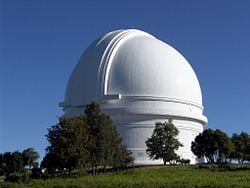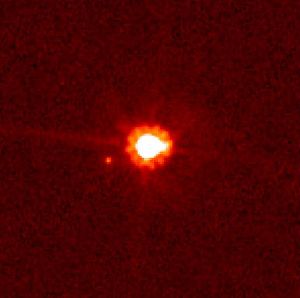Mount Palomar Observatory
Palomar Observatory is a privately owned observatory located in San Diego County, California, 90 miles southeast of Mount Wilson Observatory, on Palomar Mountain. It is owned and operated by the California Institute of Technology. The observatory currently consists of four main instruments—the 200-inch Hale Telescope, the 48-inch Samuel Oschin Telescope, the 18-inch Schmidt telescope, and a 60-inch reflecting telescope. In addition, the Palomar Testbed Interferometer[1] is located at this observatory.
Operating some 290 nights a year in clear skies at 5,600 feet above sea level, the Hale Telescope and other Palomar astronomical instruments have made numerous celestial discoveries, including hundreds of asteroids; the Eris dwarf planet; the Comet Shoemaker-Levy 9; the first, brown dwarf star; and the most distant explosion in the universe. Although the Hale Telescope was replaced as the world's largest when the Russian telescope BTA-6 became operational in the early 1980s, Mount Palomar remains an important astronomical-research facility, working in concert with others throughout the world.
The Hale Telescope
The Hale Telescope is the largest telescope at the Palomar Observatory. The 200-inch telescope is named after George Ellery Hale. Hale supervised the building of the telescopes at the Mount Wilson Observatory with grants from the Carnegie Institution of Washington—the 60-inch telescope in 1908 and the 100-inch telescope in 1917. These telescopes were very successful, leading to the rapid advance in understanding of the scale of the universe through the 1920s, and demonstrating to visionaries like Hale the need for even larger collectors.
In 1928, Hale secured a grant of six million U.S. dollars from the Rockefeller Foundation for "the construction of an observatory, including a 200-inch reflecting telescope" to be administered by the California Institute of Technology (Caltech), of which Hale was a founding member. In the early 1930s, Hale selected a site at 5,600 feet on Palomar Mountain in San Diego County, California as the best site, and less likely to be affected by the growing light–pollution problem in urban centers such as Los Angeles. The telescope (the largest in the world at that time) saw 'first light' in 1948. The American astronomer Edwin Powell Hubble was the first astronomer to use the telescope for observing.
The Hale Telescope is operated by a consortium of Caltech, Jet Propulsion Laboratory, and Cornell University. It has been used to discover hundreds of asteroids. Its tenth-scale engineering model, which still resides in Corning, New York where the telescope's optics were made, was used to discover at least one minor planet.
The 200-inch Hale remained the largest operating telescope in the world until the Russian telescope BTA-6 became operational in the early 1980s. It continues to be used every clear night (averaging about 290 nights per year) for scientific research by astronomers from Caltech and their operating partners, Cornell University and the Jet Propulsion Laboratory. It is equipped with modern optical and infrared array imagers, spectrographs, and an adaptive optics system.
Construction
Innovative techniques were developed at the Corning Glass Works in New York State permitting the successful casting on December 2, 1934 of the 200-inch Pyrex glass disc for the Hale Telescope. It took eight months for the 20-ton disc to cool, after which it was sent by rail to Pasadena, California. There, the disc was ground and polished through an intensive process that would create the exact specifications needed for astronomical observations.
In the mid-1930s, construction of the observatory to house the 200-inch disc began, including a 1,000-ton rotating dome and the telescope structure, with moving parts weighing some 530 tons. However, with the fastidious project nearly complete by 1941, the United States entered World War II, thus postponing the completion of the mirror–polishing until November 18, 1947. By then, the mirror, weighing 14.5 tons, began its final, two-day trip to Mount Palomar, where it was installed in the telescope, then tested and adjusted.
Other features
Other notable features of the observatory include:
- A 60-inch f/8.75 telescope. It was dedicated in 1970 to take some of the load off of the Hale Telescope. This telescope discovered the first brown dwarf star.
- The 48-inch Samuel Oschin Schmidt Camera. The dwarf planet Eris was discovered with this instrument in 2005.
- A 24-inch telescope completed in January 2006.
- An 18-inch Schmidt camera. Comet Shoemaker-Levy 9 was discovered in 2003 with this instrument.
- The Palomar Planet Search Telescope, a small robotic telescope dedicated to the search for planets around other stars.
- The Palomar Testbed Interferometer which allows for very high resolution measurements.
Palomar Observatory Sky Survey
The Palomar Observatory Sky Survey (POSS), sponsored by the National Geographic institute, was completed in 1958. The first plates were shot in November 1948 and the last in April 1958. This survey was performed using 14-inch blue-sensitive (Kodak 103a-O) and red-sensitive (Kodak 103a-E) photographic plates, on the 48-inch Samuel Oschin Schmidt reflecting telescope. The survey covered the sky from a declination of +90 degrees (celestial north pole) to -27 degrees and all right ascensions and had a sensitivity to +22 magnitudes (about one million times fainter than the limit of human vision). A southern extension extending the sky coverage of the POSS to -33 degrees declination was shot in 1957-1958. The final POSS consisted of 937 plate pairs.
J.B. Whiteoak, an Australian radio astronomer, used the same instrument to extend this survey further south to about -45 degrees declination, using the same field centers as the corresponding northern declination zones. Unlike the POSS, the Whiteoak extension consisted only of red-sensitive (Kodak 103a-E) photographic plates.
Until the completion of the Two Micron All Sky Survey (2MASS), POSS was the most extensive wide-field, sky survey ever. When completed, the Sloan Digital Sky Survey will surpass the POSS in depth, although the POSS covers almost 2.5 times as much area on the sky. POSS also exists in digitized form (i.e., the photographic plates were scanned), both in photographic form as the Digital Sky Survey (DSS) and in catalog form as the Minnesota Automated Plate Scanner (MAPS) Catalog.
Current research
One of the current ongoing research programs at Palomar is the Near-Earth Asteroid Tracking program. This program makes use of the Palomar Quasar Equatorial Survey Team (QUEST) Variability survey that began in the autumn of 2001 to map a band of sky around the equator. This search switched to a new camera installed on the 48-inch Samuel Oschin Schmidt Telescope at Palomar in summer of 2003 and the results are used by several projects, including the Near-Earth Asteroid Tracking project.
Another program that uses the QUEST results discovered 90377 Sedna on November 14, 2003, and around 40 Kuiper belt objects. Other programs that share the camera are Shri Kulkarni's search for gamma-ray bursts (this takes advantage of the automated telescope's ability to react as soon as a burst is seen and take a series of snapshots of the fading burst), Richard Ellis' search for supernovae to test whether the universe's expansion is accelerating or not, and S. George Djorgovski's quasar search.
The camera itself is a mosaic of 112 Charge-coupled devices (CCDs) covering the whole (four degrees by four degrees) field of view of the Schmidt telescope, the largest CCD mosaic used in an astronomical camera when built.
Other accomplishments
- An image of exotically beautiful celestial objects, christened the "Red Square," was compiled in April 2007 with data from the 200-inch Hale Telescope at Mount Palomar Observatory and the Keck-2 Telescope atop Mauna Kea, Hawaii.
- Caltech scientists in October 2006 produced the largest astronomical image ever made—152 feet long by 20 feet high—using data from the Palomar-Quest Digital Sky Survey, an ongoing project of the Samuel Oschin Telescope at Palomar Observatory.
- Astronomers at Mount Palomar from 2004 to 2006 used the High Performance Wireless Research and Education Network (HPWREN) as the data-transfer cyber infrastructure to further our understanding of the universe.
- Scientists using the NASA Swift satellite and several ground-based telescopes, including Mount Palomar Observatory's robotic 60-inch telescope, in September 2005 detected the most distant explosion yet, a gamma-ray burst from the edge of the visible universe.
Public access
The Palomar Observatory is an active research facility. However, parts of it are open to the public during the day. Visitors can take self-guided tours of 200-inch telescope daily from 9 a.m. to 4 p.m. There is a visitor's center and a gift shop on the grounds.
The observatory is located off State Route 76 in northern San Diego County, California two hours' drive from downtown San Diego, and three hours' drive from central Los Angeles.
Notes
- ↑ The Palomar Testbed Interferometer (PTI) is a long baseline near-Infrared interferometer developed by JPL for NASA and installed at Palomar Observatory. The PTI works by collecting light with three small telescopes. The large distance between the small telescopes allows for much higher resolution measurements to be made. The light is directed through pipes to the central beam combining building where it is analyzed. The separation among the three telescopes is 361 feet making the PTI effectively the largest telescope on the mountain. 216.239.51.104 Retrieved August 6, 2007.
ReferencesISBN links support NWE through referral fees
- Brunier, Serge, and Lagrange, Anne-Marie. Great Observatories of the World. Firefly Books, 2005. ISBN 978-1554070558
- Edmondson, Frank K. Aura and its US National Observatories. Cambridge University Press, 1997. ISBN 978-0521553452
- Florence, Ronald. The Perfect Machine: Building the Palomar Telescope. HarperPerennial, 1995. ISBN 0-06-092670-8
- Jacobson, Willard J., & Laubry, Cecilia J. Exploring the University: Thinking Ahead in Science. American Book Company, 1965.
- Walker, Gordon. Astronomical Observations: An Optical Perspective. Cambridge University Press, 1987. ISBN 978-0521339070
External links
All links retrieved November 26, 2014.
- The SBO Palomar Sky Survey Prints lyra.colorado.edu.
- Palomar Observatory Clear Sky Clock:Forecast of observing conditions cleardarksky.com.
Credits
New World Encyclopedia writers and editors rewrote and completed the Wikipedia article in accordance with New World Encyclopedia standards. This article abides by terms of the Creative Commons CC-by-sa 3.0 License (CC-by-sa), which may be used and disseminated with proper attribution. Credit is due under the terms of this license that can reference both the New World Encyclopedia contributors and the selfless volunteer contributors of the Wikimedia Foundation. To cite this article click here for a list of acceptable citing formats.The history of earlier contributions by wikipedians is accessible to researchers here:
The history of this article since it was imported to New World Encyclopedia:
Note: Some restrictions may apply to use of individual images which are separately licensed.


